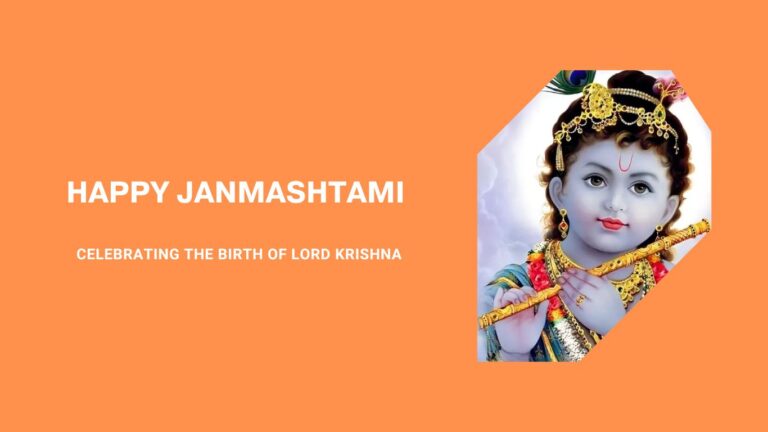Happy Janmashtami, also known as Krishna Janmashtami, is an important Hindu festival that celebrates the birth of Lord Krishna, the eighth avatar of Lord Vishnu.
This joyous occasion is great enthusiasm and fervor by millions of devotees across the world. Janmashtami falls on the eighth day (Ashtami) of the Krishna Paksha (dark fortnight) of the Bhadrapada month in the Hindu calendar, which usually falls in August or September.
Lord Krishna was born in Mathura and spent his early years in Gokul. Where he performed divine miracles and played his enchanting flute, attracting devotees of all ages. Let’s delve into the enchanting world of Happy Janmashtami and explore the customs, rituals, and significance associated with this auspicious festival.
Happy Janmashtami: The Story of Divine Birth
In this section, we will delve into the captivating tale of Lord Krishna’s birth and the divine circumstances surrounding it.
The Birth of Lord Krishna
According to Hindu mythology, Lord Krishna was born to King Vasudeva and Queen Devaki in the dungeons of Mathura. His maternal uncle, the wicked King Kansa, sought to kill him due to a prophecy that predicted Krishna would be the cause of his downfall.
The Miraculous Escape
To protect the divine infant, the gods intervened, and Lord Krishna’s parents were allowed to transfer him to Gokul secretly. In a miraculous turn of events, Vasudeva carried Krishna across the overflowing Yamuna River on the stormy night of his birth.
Lord Krishna’s Childhood
In Gokul, Krishna was raised by his foster parents, Nanda and Yashoda. His childhood has enchanting stories of his playful mischief, his endearing bond with the cowherd girls (Gopis). Also, his heroic acts of protecting the villagers from various demons.
The Significance of Happy Janmashtami
This section will highlight the profound significance of Happy Janmashtami in the Hindu religious and cultural context.
Celebration of Divine Love
Happy Janmashtami is a celebration of divine love and devotion. It symbolizes the eternal love between Lord Krishna and his devotees, exemplified by the soul-stirring accounts of his interactions with Radha and the Gopis.
Embracing Dharma (Righteousness)
Lord Krishna’s teachings in the Bhagavad Gita emphasize the importance of following one’s Dharma or righteous duty. Also, Janmashtami serves as a reminder of the significance of adhering to moral principles in life.
Victory of Good Over Evil
Krishna’s birth marks the victory of good over evil, as he ultimately vanquished the tyrannical King Kansa and restored justice and righteousness in Mathura.
Happy Janmashtami: Rituals and Traditions
This section will explore the various rituals and customs associated with the observance of Happy Janmashtami.
Fasting and Prayers
Devotees observe fasts throughout the day, breaking it only at midnight. The time when Lord Krishna was born. Hindus offer Special prayers at temples and homes to seek his blessings.
Krishna Janmashtami Decorations
Homes and temples are adorned with colorful decorations, flowers, and rangoli to create an ambiance of joy and festivity. People prepare Cradles for baby Krishna, and idols of the divine infant are beautifully dress up.
Raas Leela and Dahi Handi
In many regions people perform, Raas Leela, a traditional dance depicting Krishna’s playful interactions with the Gopis. Additionally, the Dahi Handi ritual involves forming human pyramids to reach and break a pot of curd, symbolizing Krishna’s love for dairy products.
Chanting of Hymns and Bhajans
Devotees engage in the melodious chanting of Krishna’s hymns and sing devotional bhajans throughout the day and night, expressing their love and reverence for the Lord.
FAQs about Happy Janmashtami
What is the significance of Janmashtami for Hindus?
Janmashtami holds great spiritual and cultural significance for Hindus, as it the birth of Lord Krishna, who is a divine incarnation and a symbol of love and righteousness.
How is Janmashtami celebrated across India?
Janmashtami is celebrated with regional variations, but common practices include fasting, decorating homes and temples. Performing Raas Leela, and participating in community events like Dahi Handi.
Why is midnight is the ideal time for Janmashtami celebrations?
Midnight is the time of Lord Krishna’s birth. The divine energy is at its peak during this hour, making it ideal for performing special prayers and rituals.
What are some popular delicacies prepared during Janmashtami?
Devotees prepare a wide array of sweets and savories. Including milk-based dishes like kheer and peda, as they are Lord Krishna’s favorites.
How does Janmashtami promote cultural unity and harmony?
Janmashtami transcends regional and cultural boundaries, bringing people from diverse backgrounds together to celebrate the joy of devotion and love for Lord Krishna.
What life lessons can we learn from Lord Krishna’s teachings?
Lord Krishna’s teachings in the Bhagavad Gita inspire us to perform our duties selflessly, maintain equanimity in success and failure, and strive for spiritual growth.
Conclusion:
Happy Janmashtami is not merely a festival but a celebration of love, righteousness, and the triumph of good over evil. It is a time to immerse ourselves in devotion, to cherish the divine bond with Lord Krishna, and to seek inspiration from his teachings. As we revel in the festivities, let us also remember the profound wisdom embedded in the essence of Janmashtami.
So, May the enchanting flute of Lord Krishna fill our hearts with joy and compassion, and may the spirit of Janmashtami inspire us to lead a life of love, virtue, and harmony.
Read More
Bharat Ka Naksha: भारत का नक्शा: भारत की भौगोलिक मानचित्रिका का परिचय
1 to 100 Counting in Hindi: Learn the Basics of Hindi Numerals


